Chronology and Geochemistry of Early Cretaceous Magmatism in the Northwestern Erguna Block, Northeast China
Abstract
:1. Introduction
2. Materials and Methods
3. Results
3.1. Zircon U-Pb Chronology
3.2. Whole-Rock Geochemical Characteristics
3.2.1. Major Elements
3.2.2. Trace and Rare Earth Elements (REEs)
4. Discussion
4.1. Age of Magmatic Rock Formation
4.2. Magma Source Characteristics and Petrogenesis
4.3. Tectonic Background
5. Conclusions
Supplementary Materials
Author Contributions
Funding
Data Availability Statement
Conflicts of Interest
References
- Zhang, J.H.; Gao, S.; Ge, W.C.; Wu, F.Y.; Yang, J.H.; Wilde, S.A.; Li, M. Geochronology of the Mesozoic volcanic rocks in the Great Xingan Range, northeastern China: Implications for subduction induced delamination. Chem. Geol. 2010, 276, 144–165. [Google Scholar] [CrossRef]
- Xu, B.; Zhao, P.; Bao, Q.Z.; Zhou, Y.H.; Wang, Y.Y.; Luo, Z.W. Preliminary study on the pre Meozoic tectonic unit division of the Xing Meng Orogenin Belt. Acta Petrol. Sin. 2014, 30, 1841–1857. [Google Scholar]
- Liu, Y.J.; Li, W.M.; Feng, Z.Q.; Wen, Q.B.; Neubauer, F.; Liang, C.Y. Areview of the Paleozoic tectonics in the eastern part of Central Asian Orogenic Belt. Gondwana Res. 2017, 43, 123–148. [Google Scholar] [CrossRef]
- Wu, F.Y.; Sun, D.Y.; Ge, W.C.; Zhang, Y.B.; Grant, M.L.; Wilde, S.A.; Jahn, B.M. Geochronology of the Phanerozoic granitoids in northeastern China. J. Asian Earth Sci. 2011, 41, 1–30. [Google Scholar] [CrossRef] [Green Version]
- Ji, Z.; Ge, W.C.; Yang, H.; Bi, J.H.; Yu, Q.; Dong, Y. The late Triassic Andean type and site from the central Great Xingan Range: Produces of the southward subduction of the Mongol Okhotsk oceanic plate. Acta Petrol. Sin. 2018, 34, 2917–2930. [Google Scholar]
- Wang, W. Geochronology and Geochemistry of the Early Jurassic Volcanic Rocks in the Manzhouli−Erguna Area, NE China; Inner Mongolia: Changchun, China, 2014. [Google Scholar]
- Li, Y.; Wang, J.; Han, Z.B.; Hou, X.G.; Wang, S.Y. Zircon U−Pb Dating And Petrogensis of The Early Jurassic Rhyolite In Badaguan from Northen of Daxinganling Moutains. Geol. China 2017, 44, 346–357. [Google Scholar]
- Zhou, J.B.; Wilde, S.A.; Zhao, G.C.; Han, J. Nature and assembly of microcontiental blocks within the Paleo Asian Ocean. Earth Sci. Rev. 2018, 186, 76–93. [Google Scholar] [CrossRef]
- Zhang, J.H.; Ge, W.C.; Wu, F.Y.; Wilde, S.A.; Yang, J.H.; Liu, X.M. Large-scale Early Cretaceous volcanic events in the northern Great Xing’an Range, Northeastern China. Lithos 2008, 102, 138–157. [Google Scholar] [CrossRef]
- Zheng, H.; Sun, X.M.; Wan, K.; Wang, P.J.; He, S.; Zhang, X.Q. Structure and tectonic evolution of the Late Jurassic–Early Cretaceous Wandashan accretionary complex, NE China. Int. Geol. Rev. 2018, 61, 17–38. [Google Scholar] [CrossRef]
- Li, J.Y. Permian geodynamic setting of Northeast China and adjact regions: Closure of the Paleo Asin Ocean and subduction of the Paleo Pacific Plate. J. Asian Earth Sci. 2006, 26, 207–224. [Google Scholar] [CrossRef]
- Liu, X.W.; Yang, H.; Dong, Y.; Wang, Q.H.; Ge, W.C.; Zhang, Y.L.; Tian, D.X. Zircon U-Pb ages and geochemical characteristics of the Trassic granites from the Mingshui area in the Da Hinggan Mountains and their tectonic implications. Acta Petrol. Mineral. 2015, 34, 143–158. [Google Scholar]
- Dong, Y.; Ge, W.C.; Yang, H.; Wang, Q.; Zhang, Y.; Su, L. Geochronology and geochemistry of Early Cretaceous volcanic rocks from the Baiyingaolao Formation in the central Great Xing’an Range, NE China, and its tectonic implications. Lithos 2014, 205, 168–184. [Google Scholar] [CrossRef]
- Sun, D.Y.; Gou, J.; Wang, T.H.; Ren, Y.S.; Liu, Y.J.; Guo, H.Y.; Liu, X.M.; Zhao, C.H. Geochronological and geochemical constraints on the Erguna massif basement, NE China-Subduction history of the Mongol-Okhotsk oceanic crust. Int. Geol. Rev. 2013, 55, 1801–1816. [Google Scholar] [CrossRef]
- Tang, J.; Xu, W.L.; Wang, F.; Wang, W.; Xu, M.J.; Zhang, Y.H. Geochronology and geochemistry of Early–Middle Triassic magmatism in the Erguna Massif, NE China: Constraints on the tectonic evolution of the Mongol-Okhotsk suture belt. Lithos 2014, 184–187, 1–16. [Google Scholar] [CrossRef]
- Li, Y.; Wang, J.; Sun, D.Y.; Chen, D.B.; Han, Z.B.; Cui, J.R. Age, Geochemistry and Petrogenesis of granites from Badaguan area in Northern Hailaer, Inner Mongolia. Geoscience 2017, 31, 234–245. [Google Scholar]
- Mi, K.; Liu, Z.; Li, C.; Liu, R.; Wang, J.; Peng, R. Origin of the Badaguan porphyry Cu-Mo deposit, Inner Mongolia, northeast China: Constraints from geology, isotope geochemistry and geochronology. Ore Geol. Rev. 2017, 81, 154–172. [Google Scholar] [CrossRef]
- Mao, A.Q.; Sun, D.Y.; Yang, D.G.; Tang, Z.Y.; Zheng, H. Petrogenesis and tectonic implications of Early Cretaceous volcanic rocks from the Shanghulin Basin within the north-western Great Xing’an Range, NE China: Constraints from geochronology and geochemistry. Geol. J. 2019, 55, 3476–3496. [Google Scholar] [CrossRef]
- Tang, J.; Xu, W.L.; Wang, F.; Wang, W.; Xu, M.J.; Zhang, Y.H. Geochronology and geochemistry of Neoproterozoic magmatism in the Erguna Massif, NE China: Petrogenesis and implications for the breakup of the Rodinia supercontinent. Precambrian Res. 2013, 224, 597–611. [Google Scholar] [CrossRef]
- Bureau of Geology and Mineral Resources of Heilongjiang Province. Regional Geology of Heilongjiang Province; Geological Publishing House: Beijing, China, 1993. [Google Scholar]
- Bureau of Geology and Mineral Resources of Heilongjiang Province. The Rock Formation of Heilongjiang Province; China University of Geosciences Press: Wuhan, China, 1997. [Google Scholar]
- Anderson, T. Correction of common lead in U-Pb analyses that do not report 204Pb. Chem. Geol. 2002, 192, 59–79. [Google Scholar] [CrossRef]
- Yuan, H.L.; Wu, F.Y.; Gao, S.; Liu, X.M.; Xu, P.; Su, D.Y. Age determination and rare earth element composition analysis of U-Pb laser probe and invaded human body in Cenozoic era in northeast China. Chin. Sci. Bull. 2003, 48, 1510–1520. [Google Scholar]
- Belousova, E.A.; Griffin, W.L.; O’Reilly, S.Y. Igneous zircon: Trace element composition as an indicator of source rock type. Contrib. Mineral. Petrol. 2002, 143, 602–622. [Google Scholar] [CrossRef]
- Qiu, J.S.; Hu, J.; Wang, X.L.; Jiang, S.Y.; Wang, R.C.; Xu, X.S. The Baishigang pluton in Heyuan, Guangdong Province. A highly fractionated I-type granite. Acta Petrol. Sin. 2005, 79, 503–514. [Google Scholar]
- Eby, G.N. The A-type granitoids: A review of their occurrence and chemical characteristics and speculations ontheir petrogenesis. Lithos 1990, 26, 115–134. [Google Scholar] [CrossRef]
- Xiao, Z.J.; Wang, Z.Q.; Zhao, C.Y.; Wu, Y. The Discovery of Monzogranite and Its Geologic Implicationin Adenxile, Sonid Zuoqi, Innner Mongoliat. Geol. Rev. 2015, 61, 777–786. [Google Scholar]
- Fan, F.P.; Xiao, H.L.; Chen, L.Z.; Cai, Y.T.; Li, H.L. High-diversity granite and its metallogenic characteristics in South Gannan-North Guangdong area. Geol. Rev. 2017, 63, 171–172. [Google Scholar]
- Maniar, P.D.; Piccoli, P.M. Tectonic discrimination of granitoids. Geol. Soc. Am. Bull. 1989, 101, 635–643. [Google Scholar] [CrossRef]
- Peccerillo, A.; Taylor, S.R. Geochemistry of Eocene Calc-alkaline volcanic rocks from the Kastamonu Area, Northern Turkey. Contrib. Mineral. Petrol. 1976, 58, 63–81. [Google Scholar] [CrossRef]
- Fu, C.L.; Sun, D.Y.; Zhang, X.Z.; Wei, H.Y. Discovery and geological significance of the Triassic high-Mg diorites in Hunchun area, Jilin Province. Acta Petrol. Sin. 2010, 26, 1089–1102. [Google Scholar]
- Boynton, W.V. Cosmochemistry of the rare earth elements: Meteorite studies. In Rare Earth Element Geochemistry; Developments in Geochemistry; Henderson, P., Ed.; Elsevier: Amsterdam, The Netherlands, 1984; pp. 63–114. [Google Scholar]
- Sun, S.S.; McDonough, W.F. Chemical and isotopic systematics of oceanic basalts: Implications for mantle composition and processes. In Magmatism in the Ocean Basins; Saunders, A.D., Norry, M.J., Eds.; Geological Society, Special Publications: London, UK, 1989; Volume 42, pp. 313–345. [Google Scholar]
- Wang, F.; Zhou, X.H.; Zhang, L.C.; Ying, J.F.; Zhang, Y.T.; Wu, F.Y.; Zhu, R.X. Late Mesozoic volcanism in the Great Xing’an Range (NE China): Timing and implications for the dynamic setting of NE Asia. Earth Planet. Sci. Lett. 2006, 251, 179–198. [Google Scholar] [CrossRef]
- Xu, M.J.; Xu, W.L.; Meng, E.; Wang, F. LA-ICP-MS zircon U-Pb chronology and geochemistry of Mesozoic volcanic rocks from the Shanghulin–Xiangyang basin in Ergun area, northeastern Inner Mongolia. Geol. Bull. China 2011, 30, 1321–1338. [Google Scholar]
- Meng, E.; Xu, W.L.; Yang, D.B.; Qiu, K.F.; Li, C.H.; Zhu, H.T. Zircon U-Pb chronology, geochemistry of Mesozoic volcanic rocks from the Lingquan basin in Manzhouli area, and its tectonic implications. Acta Petrol. Sin. 2011, 27, 1209–1226. [Google Scholar]
- Gou., J.; Sun, D.Y.; Ren, Y.S.; Liu, Y.J.; Zhang, S.Y.; Fu, C.L.; Liu, X.M. Petrogenesis and geodynamic setting of Neoproterozoic and Late Paleozoic magmatism in the Manzhouli-Erguna area of Inner Mongolia, China: Geochronological, geochemical and Hf isotopic evidence. J. Asian Earth Sci. 2013, 67–68, 114–137. [Google Scholar] [CrossRef]
- Gou, J.; Sun, D.Y.; Zhao, Z.H.; Ren, Y.S.; Zhang, X.Y.; Fu, C.L.; Wei, H.Y. Zircon LA-ICPMS U-Pb dating and petrogenesis of rhyolite in Baiyingaolao Formation from the southern Manzhouli, Inner-Mongolia. Acta Petrol. Sin. 2010, 26, 333–344. [Google Scholar]
- Chappell, B.W. Aluminium saturation in I and S−type granites and the characterization of fractionated haplogranites. Lithos 1999, 46, 535–551. [Google Scholar] [CrossRef]
- Tischendorf, G.; Paelchen, W. Zur Klassifikation von Granitoiden. Classif. Granitoids Z. Fuer Geol. Wiss. 1985, 13, 615–627. [Google Scholar]
- Sui, Z.M.; Ge, W.C.; Wu, F.Y.; Zhang, J.H.; Xu, X.X.; Cheng, R.Y. Zircon U-Pb ages, geochemistry and its petrogenests of Jurassic granites in northeastern part of the Da Higgans Mts. Acta Petrol. Sin. 2007, 23, 461–480. [Google Scholar]
- Defant, M.J.; Drummond, M.S. Derivation of some modern arc magmas by melting of young subducted litho sphere. Nature 1990, 347, 662–665. [Google Scholar] [CrossRef]
- Shi, L.; Zheng, C.Q.; Yao, W.G.; Li, J.; Cui, F.; Gao, F.H.; Han, X.M. Geochronological framework and tectonic setting of the granitic magmatism in the Chaihe–Moguqi region, central Great Xing’an Range, China. J. Asian Earth Sci. 2015, 113, 443–453. [Google Scholar] [CrossRef]
- Sun, C.Y.; Tang, J.; Xu, W.L.; Li, Y.; Zhao, S. Crustal accretion and reworking processes of micro-continental massifs within orogenic belt: A case study of the Erguna Massif, NE China. Sci. China Earth Sci. 2017, 60, 1256–1267. [Google Scholar] [CrossRef]
- Sun, L.X.; Ren, B.F.; Zhao, F.Q.; Ji, S.P.; Geng, J.Z. Late Paleoproterozoic magmatic records in the Erguna massif: Evidences from the zircon U-Pb dating of granitic gneisses. Geol. Bull. China 2013, 32, 341–352. [Google Scholar]
- Wang, W.; Tang, J.; Xu, W.L.; Wang, F. Geochronology and geochemistry of Early Jurassic volcanic rocks in the Erguna Massif, northeast China: Petrogenesis and implications for the tectonic evolution of the Mongol-Okhotsk suture belt. Lithos 2015, 218–219, 73–86. [Google Scholar] [CrossRef]
- Xu, L.M. Chronology and Geochemistry of the Early Cretaceous Intrusive Rocksin the Southern of Tahe, Northern Great Xing’an Range; China University of Geosciences: Beijing, China, 2017; pp. 1–63. [Google Scholar]
- Lin, Q.; Ge, W.C.; Cao, L.; Sun, D.Y.; Lin, J.G. Geochemistry of Mesozoic volcanic rocks in Da Hinggan Ling: The bimodal volcanic rocks. Geochimica 2003, 32, 208–222. [Google Scholar]
- Ge, W.C.; Wu, F.Y.; Zhou, C.Y.; Abdel Rahman, A.A. Emplacement age of the Tahe granite and its constraints on the tectonic nature of the Erguna Block in the northern part of the Da Hinggan Range. Chin. Sci. Bull. 2005, 50, 2097–2105. [Google Scholar] [CrossRef]
- Gu, A.L.; Sun, J.G.; Bai, L.A.; Zhang, Y.; Cui, P.L.; Chai, P.; Zhu, J.Q. Petrogenesis and geodynamic significance of the Ganhe Formation lavas, eastern Great Xing’an Range, China: Evidence from geochemistryand geochronology. Isl. Arc 2016, 25, 87–110. [Google Scholar] [CrossRef]
- Ouyang, H.; Mao, J.; Zhou, Z.; Su, H. Late Mesozoic metallogeny and intracontinental magmatism, southern Great Xing’an Range, northeastern China. Gondwana Res. 2015, 27, 1153–1172. [Google Scholar] [CrossRef]
- Ying, J.F.; Zhou, X.H.; Zhang, L.C.; Wang, F. Geochronological framework of Mesozoic volcanic rocks in the Great Xing’an Range, NE China, and their geodynamic implications. J. Asian Earth Sci. 2010, 39, 786–793. [Google Scholar] [CrossRef]
- Zhou, Z.B.; Pei, F.P.; Wang, Z.W.; Cao, H.H.; Xu, W.L.; Wang, Z.J.; Zhang, Y. Using detrital zircons from late Permian to Triassic sedimentary rocks in the south-eastern central Asian Orogenic Belt (NE China) to constrain the timing of the final closure of the Paleo-Asian Ocean. J. Asian Earth Sci. 2017, 144, 82–109. [Google Scholar] [CrossRef]
- Amarjargal, B.; Miao, L.C.; Zhang, F.; Munkhtsengel, B.; Chimedtseren, A.; Khasmaral, T. Petrogenesis and tectonic implication of the Late Mesozoic volcanic rocks in East Mongolia. Geol. J. 2018, 53, M2449–M2470. [Google Scholar]
- Sun, D.Y.; Gou, J.; Ren, Y.S.; Fu, C.L.; Wang, X.; Liu, X.M. Zircon U-Pb dating and study on geochemistry of volcanic rocks in Manitu Formation from southern Manchuria, Inner Mongolia. Acta Petrol. Sin. 2011, 27, 3083–3094. [Google Scholar]



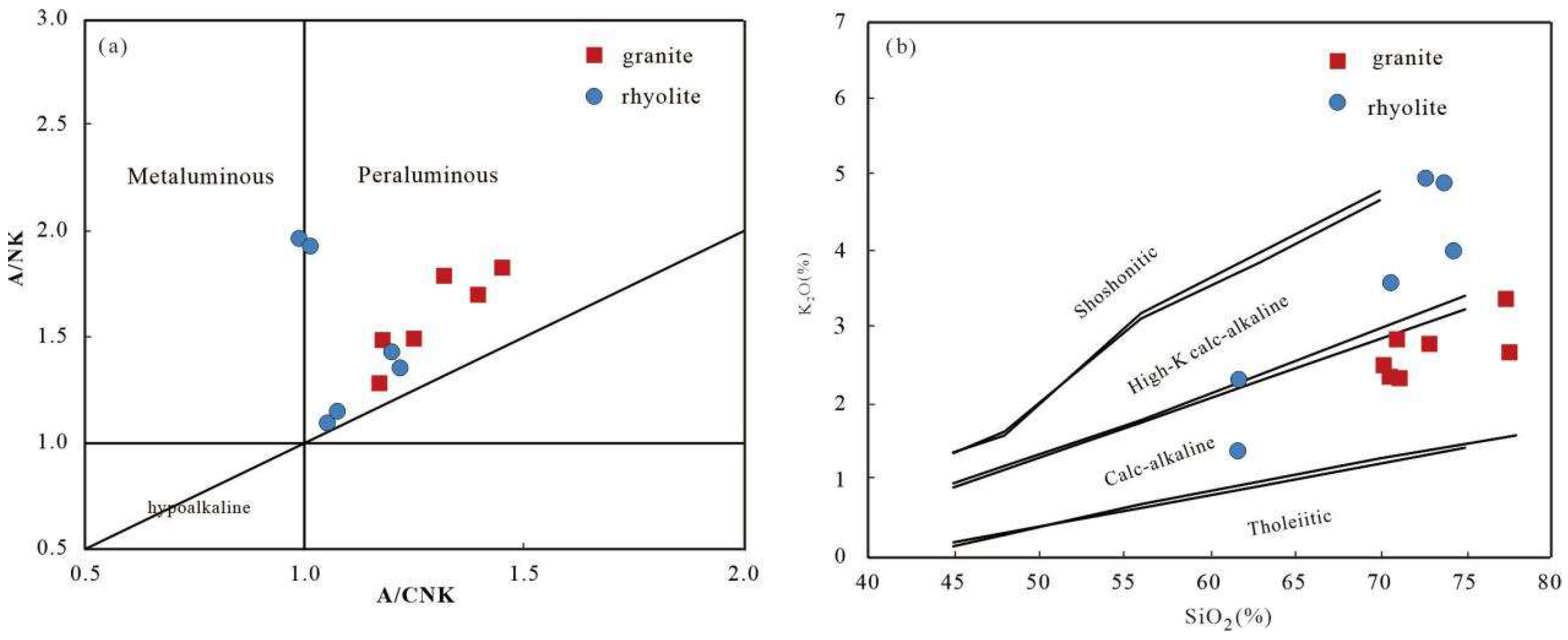
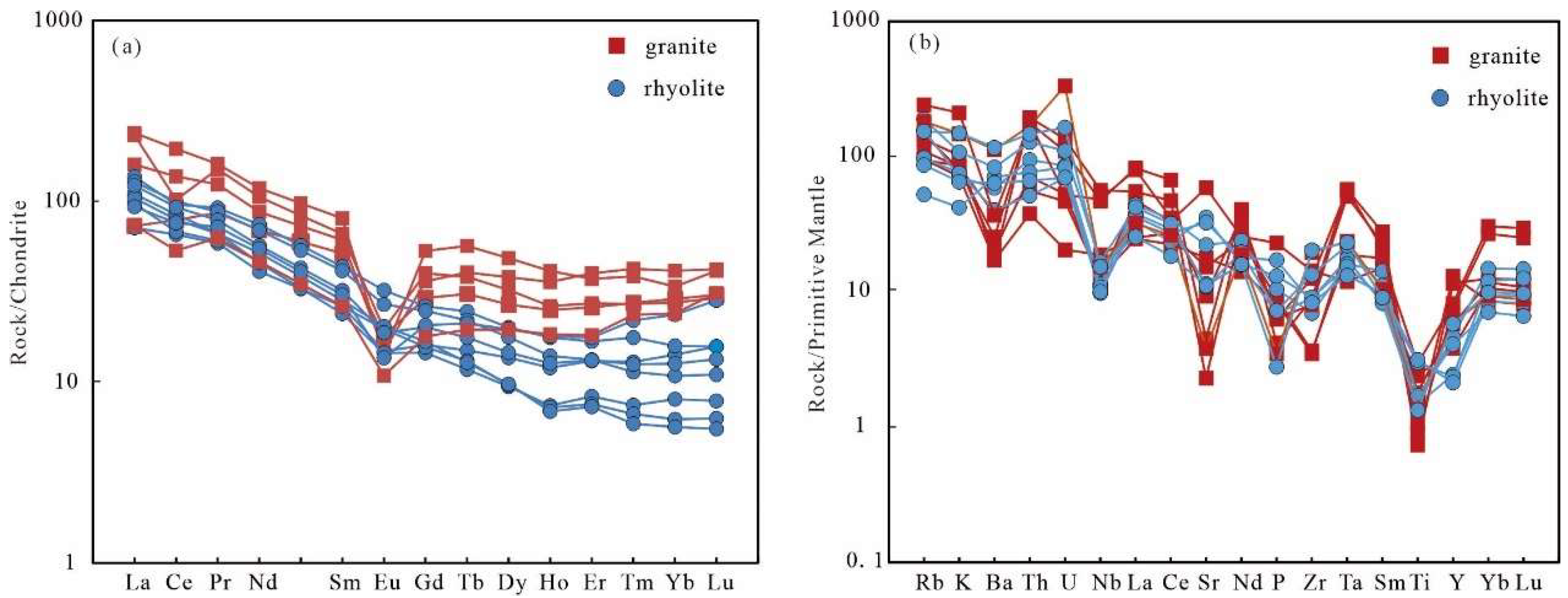
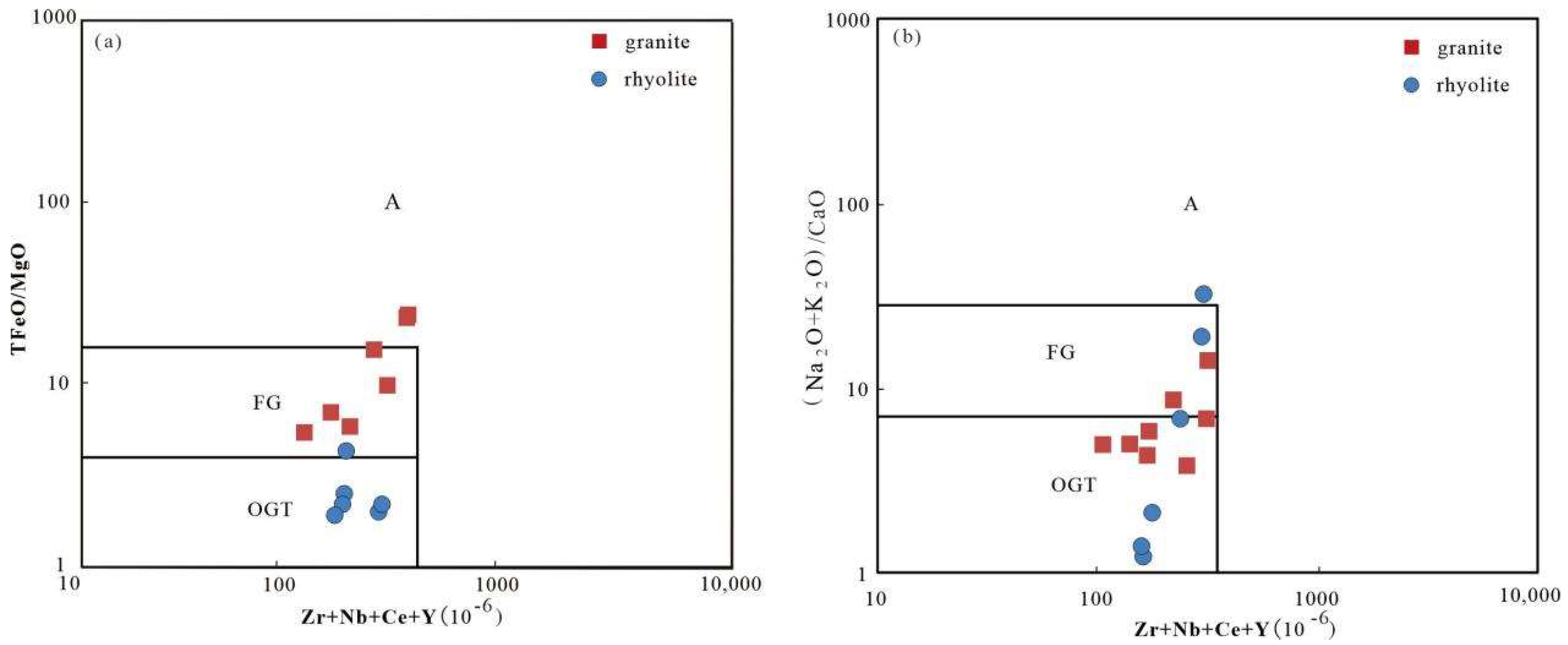
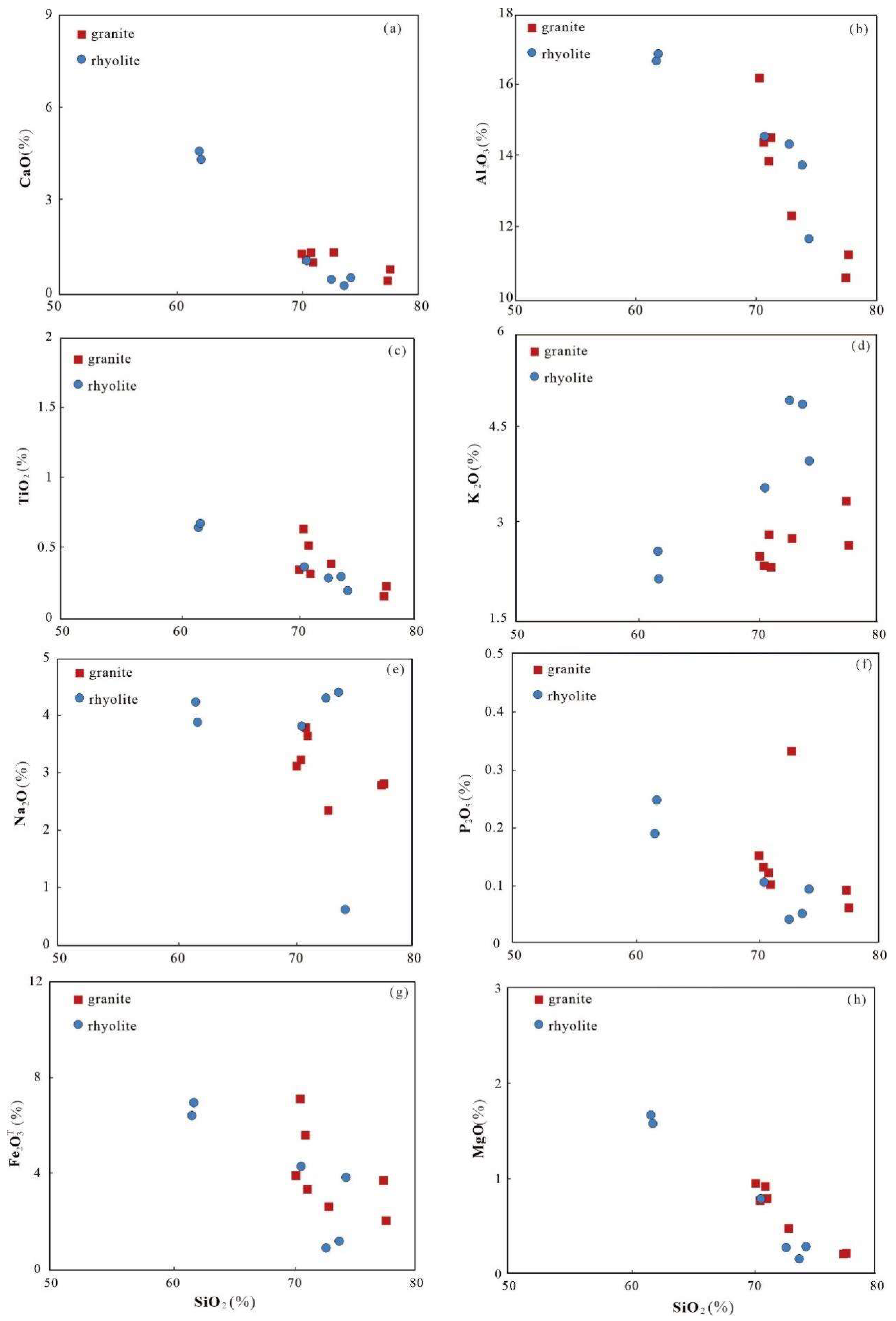
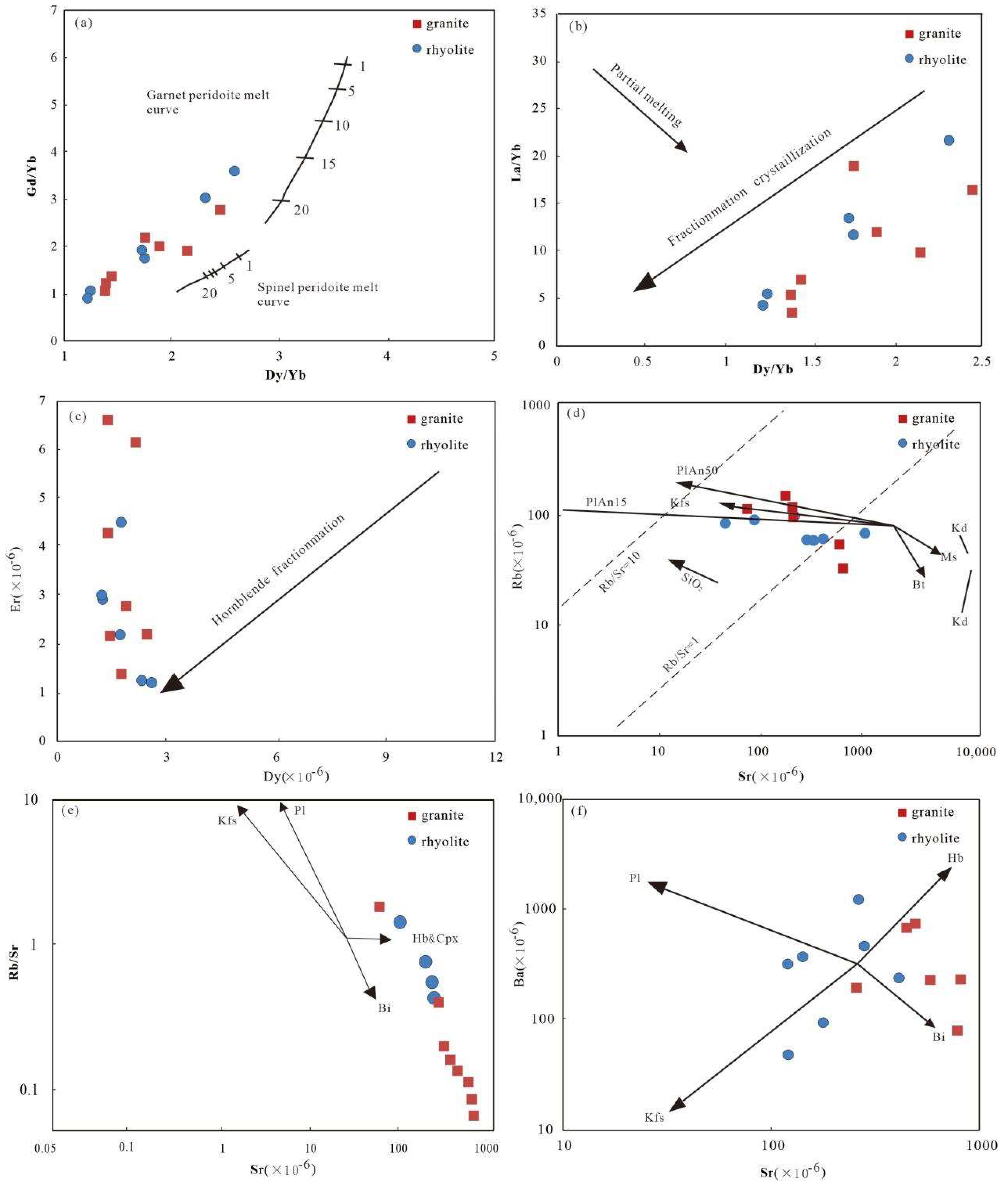

Publisher’s Note: MDPI stays neutral with regard to jurisdictional claims in published maps and institutional affiliations. |
© 2022 by the authors. Licensee MDPI, Basel, Switzerland. This article is an open access article distributed under the terms and conditions of the Creative Commons Attribution (CC BY) license (https://creativecommons.org/licenses/by/4.0/).
Share and Cite
Li, Y.; Cui, J.-R.; Han, Z.-B.; Nie, F.-J.; Hou, X.-G.; Yan, Z.-B. Chronology and Geochemistry of Early Cretaceous Magmatism in the Northwestern Erguna Block, Northeast China. Minerals 2022, 12, 303. https://doi.org/10.3390/min12030303
Li Y, Cui J-R, Han Z-B, Nie F-J, Hou X-G, Yan Z-B. Chronology and Geochemistry of Early Cretaceous Magmatism in the Northwestern Erguna Block, Northeast China. Minerals. 2022; 12(3):303. https://doi.org/10.3390/min12030303
Chicago/Turabian StyleLi, Yan, Jia-Rui Cui, Zhi-Bin Han, Feng-Jun Nie, Xiao-Gung Hou, and Zhao-Bin Yan. 2022. "Chronology and Geochemistry of Early Cretaceous Magmatism in the Northwestern Erguna Block, Northeast China" Minerals 12, no. 3: 303. https://doi.org/10.3390/min12030303




